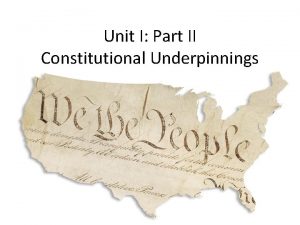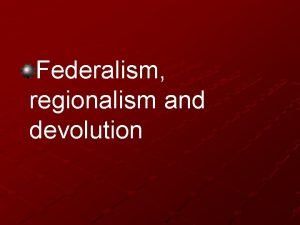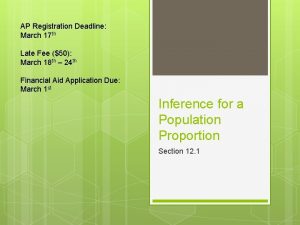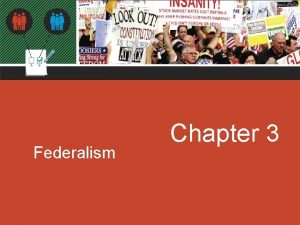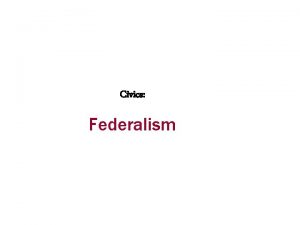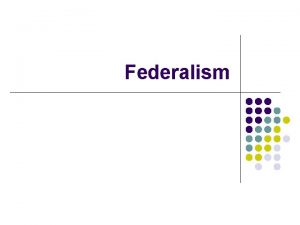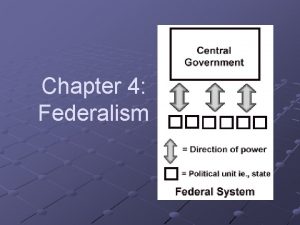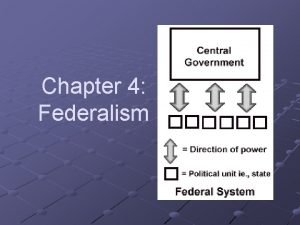CORPORATE CHARTERING AND FEDERALISM A NEW VIEW Ronald












- Slides: 12

CORPORATE CHARTERING AND FEDERALISM: A NEW VIEW Ronald J. Gilson Columbia Law School Stanford Law School Henry Hansmann Yale Law School Mariana Pargendler Fundação Getulio Vargas Law School at São Paul

Corporate Chartering in a Federal System • Three Approaches: – Real Seat Doctrine – Free Incorporation (Internal Affairs Rule) – Federal Chartering • Common assumption is that free incorporation promotes regulatory competition -- either: – Active Competition: states alter their corporation law to attract chartering business from other states or – Passive Competition: Firms obtain charters in states whose law they find congenial, without regard to states’ motives for establishing that law 2

Both Active and Passive Competition Are Assumed to Yield Legal HOMOGENEITY • Active competition: All states will adopt similar corporation law • Passive competition: All firms will incorporate in the same state • Academic debate then focuses on whether the winning body of corporate law is good or bad for overall social welfare • Those who like the resulting body of corporate law like free incorporation; others may prefer the real seat doctrine or federal chartering 3 3

We See a Different Dynamic • We have termed this dynamic REGULATORY DUALISM, in contrast with REGULATORY COMPETITION. • In this interpretation, free incorporation creates pressure for HETEROGENEITY in corporate law • We view firms as choosing between two strategies: – Those seeking MARKET-ORIENTED law • Open to market for corporate control • Imposes strong fiduciary duties on controlling shareholders and managers – Those seeking POLITICS-ORIENTED law • Companies have sufficient influence as to keep corporate (and other) law favorable to them 4

The U. S. Example • Delaware provides market-oriented law – Chosen by most U. S. exchange-listed companies • The other 49 states (except Nevada) provide politics-oriented law – They’re not actively competing for charters – Chosen by locally-headquartered firms seeking to maximize their influence on legal matters that affect them • Corporate law • Products liability • Building permits 5

Complementarity • Delaware is free of political pressure on its corporate law – Corporate constituencies aren’t resident in the state – So it can offer a regime that’s strongly marketoriented • Result: other states are relieved of pressure from local companies seeking market-oriented law. – Those companies have the opportunity of reincorporating in Delaware – So other states can favor local interests 6

Some Evidence • Delaware law offers (somewhat) more protection to non-controlling shareholders from controlling shareholders and entrenched managers • Companies seek charters almost exclusively from either Delaware or their headquarters state. – A third state would yield little political influence • Notoriously, individual companies have induced state legislatures to amend corporation law quickly, against the wishes of shareholders. • The smaller states have the largest rate of instate incorporation 7

Federal Corporation Law Would Be a Compromise • It would need to be responsive both to those companies that favor market-oriented law and those that have some political influence (individually or in groups) on the federal government • We cannot say a priori whether this would be a social welfare improvement – The disputes over Sarbanes-Oxley and Dodd. Frank reflect this 8

Europe • Centros (1999) replaced real seat doctrine with free incorporation – But little cross-border chartering resulted • Just enough for lowering minimum capital requirements – Difficult, for lack of a state like Delaware • EU has also failed at substantive federal-level “harmonization“ • EU now moving toward legislated regulatory dualism based on age and size of firms – Lets established firms retain politics-oriented old legal order – Allows new and growing firms to enter a market-oriented regime. • For example, under tax and cross-border merger regimes: – Codetermination is effectively grandfathered • Will probably last longer as a result – States and individual firms can choose exposure to hostile takeovers • Will probably extend life of entrenchment in many firms 9

Vertical Regulatory Dualism? • The Societas Europea offers choice of federal chartering – In theory an alternative market-oriented regime – But very little used Doesn’t offer either pole of regulatory dualism – No bond to market: • Subject to both home state and federal level politics – Yet little political influence for individual firms • Similar U. S. effort at choice of state or federal bank charters failed 10

Conclusion • Free incorporation has potentially important, and frequently overlooked, consequences for the politics of law-making – It can isolate some of the political resistance to market-oriented law – But at the same time it can concentrate and prolong resistance to overall efficient reforms • It will be interesting to see these forces play out in Europe in the years to come 11

Potential Dynamics Under Free Incorporation • Regulatory Diversification: Corporations are heterogeneous in their need for corporate law • Regulatory Experimentation: Corporations may be homogeneous. It is unclear which legal regime(s) is most efficient • Regulatory Competition: Corporations are homogeneous, but competition is needed to induce all jurisdictions to adopt it. • Regulatory Dualism: Corporations are homogeneous, but a single body of law would frustrate the ability to offer firms a strongly market-oriented body of law THEY AREN’T MUTUALLY EXCLUSIVE
 Liner vs tramp
Liner vs tramp Texas 4-h chartering
Texas 4-h chartering Ship chartering courses
Ship chartering courses Constitutional underpinnings definition
Constitutional underpinnings definition Objectives of corporate governance
Objectives of corporate governance Difference between regionalism and federalism in a sentence
Difference between regionalism and federalism in a sentence Steve jobs steve wozniak and ronald wayne
Steve jobs steve wozniak and ronald wayne Gloria chavez and ronald flynn
Gloria chavez and ronald flynn Conditional evidence examples
Conditional evidence examples Lowell lee andrews
Lowell lee andrews Birds eye view camera angle
Birds eye view camera angle Simple view and complex view
Simple view and complex view Simple view and complex view
Simple view and complex view



